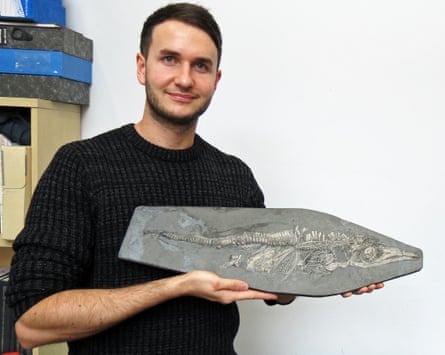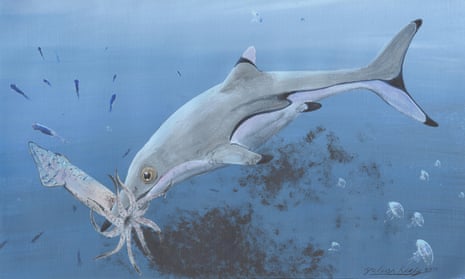Not all new palaeontology discoveries are made on dramatic rocky outcrops. Sometimes dusty drawers in the back-rooms of museums are the source of exciting discoveries. A new study by Dean Lomax, a researcher at the University of Manchester, and colleagues on a previously neglected specimen in the the Lapworth Museum of Geology, University of Birmingham, UK, has increased our knowledge of how the youngest ichthyosaurs - a group of extinct marine reptiles - lived and fed.
Ichthyosaurs were a diverse group of marine reptiles, viewed as the Mesozoic equivalent of modern day whales and dolphins (and a prime example of convergent evolution in action). With streamlined bodies, flippers and tail flukes, they evolved from a reptilian ancestor on land to become highly adapted to an exclusively marine lifestyle. Ranging from smaller, agile hunters less than a metre long to 20-metre, toothless suction feeders like Shastasaurus, we already know a fair deal about these animals – which died out about 95 million years ago – from exceptionally well-preserved fossils.
Ichthyosaur fossils often make for dramatic storytelling. Many specimens have been found that show us one of the group’s key adaptations to a fully aquatic life: they gave birth to live young, the skeletons of which can be seen within the mother’s body. Some specimens even appear to show animals caught in the very act of giving birth, although the reality is probably rather less romantic: a build-up of gases in the decaying carcass probably pushed the embryo halfway out of the birth canal (something which can be seen today in stranded pregnant whale carcasses).
The same exquisite preservation of more or less complete skeletons means that we know a lot about ichthyosaur diets too. The gastric contents of ichthyosaurs have been studied in fossils from the early Jurassic (around 190 Ma) shales of Lyme Regis and Whitby in the UK for more than 150 years, and from the slightly younger Posidonia Shale near Holzmaden in Germany. Early Jurassic ichthyosaur stomachs were densely packed with hooklets from the limbs of squids, with some also containing fish scales and other remains. Conversely, coprolites (fossil faeces) thought to have been produced by the same ichthyosaurs contain fish scales and spikes but fewer contain squid hooklets – which presumably built up in the animal’s stomach. By contrast, a younger, early Cretaceous, ichthyosaur graveyard found in Chile shows large numbers of individuals, of all ages, thought to be hunting for fish and belemnites, and a regurgitation pellet containing pterosaur remains.
The specimen which Lomax and colleagues describe is an Ichthyosaurus communis, the type species for Ichthyosaurus, which was initially described back in 1822. And it’s small: only 70cm long, and the smallest known which has been positively identified as a member of this species. Combine its overall size with a sclerotic ring (eye bones) which fill the orbit space, and bones which are not fully ossified, and you have key indicators that it was very young when it died.

So why is this a newborn and not another ichthyosaur foetus? Firstly, it isn’t within or associated with a larger individual. Secondly, its last meal is also preserved: it has squid hooks in its rib region. This is interesting, because previous studies on Stenopterygius, a similar ichthyosaur from Holzmaden, found that the young of that species fed exclusively on fish, before switching to a squid-rich diet as they matured. Different species preferred different baby foods.
One problem with back-room discoveries is that you don’t always have all the contextual data you would wish for. Sadly, this is the case for this newborn Ichthyosaurus specimen, which lacks any information on where it was collected and from which stratigraphic layer. Lomax and colleagues used another palaeontological technique to help to address this, by getting a small fragment of the rock analysed for microfossils. The ostracods and foraminifera which were found allowed them to pinpoint the age of the specimen to around 199 Ma (very latest Hettangian to very earliest Sinemurian of the Lower Jurassic), though since rocks of this age are widespread across the UK, it hasn’t helped them to establish a likely locality.
Reference
Lomax, D. R., Larkin, N. R., Boomer, S., Dey, S. and Copestake, P. 2017. The first known neonate Ichthyosaurus communis skeleton: a rediscovered specimen from the Lower Jurassic, UK. Historical Biology, https://doi.org/10.1080/08912963.2017.1382488

Comments (…)
Sign in or create your Guardian account to join the discussion